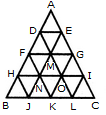Non Verbal Reasoning - Analytical Reasoning - Discussion
Discussion Forum : Analytical Reasoning - Section 2 (Q.No. 19)
19.
Count the number of parallelogram in the given figure.

Answer: Option
Explanation:
The figure may be labelled as shown.

The parallelograms composed of two components each are ADME, DFNM, EMOG, FHJN, MNKO, GOLI, HBJN, NJKO, OKLI, FHNM, MNOG, DFME, HJKN, NKLO, OLCI, FNOM, MOIG and DMGE. i.e. 18 in number.
The parallelograms composed of four components each are HOKB, NILJ, FGOH, HOLJ, NICK, FGIN, FMJB, DENH, MGKJ, MGCL, DEIO, FMLK, AENF, AGOD, DMJH, DOKF, EILM and EGKN i.e. 18 in number.
The parallelograms composed of six components each are AEJH, DAIL, DECL, DEJB, HILB and HICJ i.e. 6 in number.
The parallelograms composed of eight components each are FGKB, FGCK and AGKF i.e. 3 in number.
Total number of parallelograms in the figure = 18 + 18 + 6 + 3 = 45.
Discussion:
16 comments Page 2 of 2.
Paras said:
9 years ago
As I too got 27 triangles.
Rajeev said:
9 years ago
I found two answers they are 27 and 45. Can someone tell me which is the right answer?
Badri said:
9 years ago
But I got 27 triangles in total.
Babeen kumar said:
9 years ago
Is there any formula to find out the parallelogram? Please tell me.
Uresh kannah said:
9 years ago
To find the no of triangles in this kind of picture use this formula : [n (n + 2) (2n + 1)]/8. Where n is no of rows.
Kavita yadav said:
1 decade ago
How many triangles are in this triangle? Can anybody help me?
Post your comments here:
Quick links
Quantitative Aptitude
Verbal (English)
Reasoning
Programming
Interview
Placement Papers